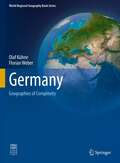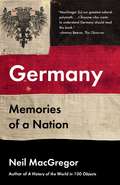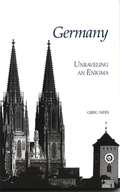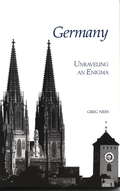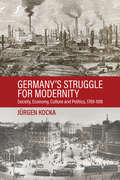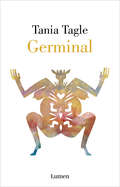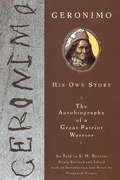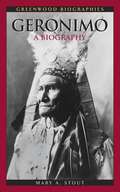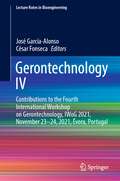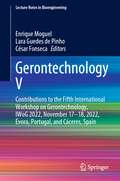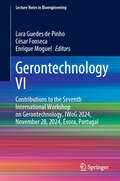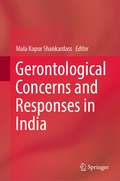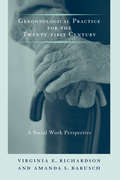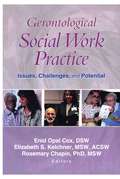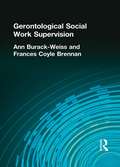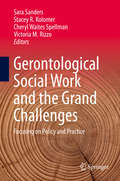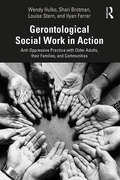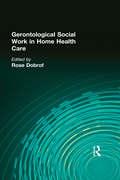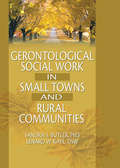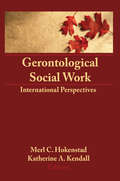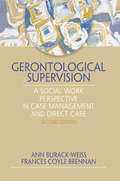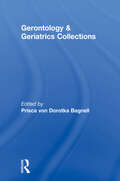- Table View
- List View
Germany: Geographies of Complexity (World Regional Geography Book Series)
by Olaf Kühne Florian WeberThis book addresses the highly differentiated spatial, social, cultural and demographic structure(s) of Germany, with a particular focus on the reciprocal relations between different levels of spatial development. The historical development of Germany serves as a background in order to provide context for the development of spatially relevant ideas and ideals (whether in relation to politics, landscape, or culture). In this regard, questions of divergence and convergence become highly salient. The book makes the complexity of spatial and social developments in Germany comprehensible. The neopragmatic approach adopted here allows bringing together different theoretical strands while providing a basis for independent regional geographic research at the same time. Beginning with an overview of the physical structures of Germany which provides the material point of departure for the societal development of Germany, key aspects of the German history are discussed. Particular attention is paid to the reciprocal influence between material substrate and notions of landscape. Here, specific ‘German’ trajectories of aesthetic and normative conceptions of landscape become clear. A common theme throughout the book are questions of divergence and of efforts towards convergence, which become evident when considering past and present economic, political, and demographic developments. Efforts to tackle current challenges, such as adapting to climate change and mitigating it, or securing raw materials, also become apparent. The complexity of spatial processes in Germany is illustrated in case study regions dealing with the challenges of structural change in traditional industrial regions (such as the Ruhr area), or e.g. efforts of Berlin to position and find itself as the capital of a unified Germany. Overall, the book shows how theory-driven regional geographic research can make spatiotemporal complexities tangible and comprehensible.
Germany: Memories of a Nation
by Neil MacgregorFor the past 140 years, Germany has been the central power in continental europe. Twenty-five years ago a new German state came into being. How much do we really understand this new Germany, and how do its people understand themselves?Neil MacGregor argues that, uniquely for any European country, no coherent, overarching narrative of Germany's history can be constructed, for in Germany both geography and history have always been unstable. Its frontiers have constantly shifted. Königsberg, home to the greatest German philosopher, Immanuel Kant, is now Kaliningrad, Russia; Strasbourg, in whose cathedral Wolfgang von Geothe, Germany's greatest writer, discovered the distinctiveness of his country's art and history, now lies within the borders of France. For most of the five hundred years covered by this book Germany has been composed of many separate political units, each with a distinct history. And any comfortable national story Germans might have told themselves before 1914 was destroyed by the events of the following thirty years.German history may be inherently fragmented, but it contains a large number of widely shared memories, awarenesses, and experiences; examining some of these is the purpose of this book. MacGregor chooses objects and ideas, people and places that still resonate in the new Germany--porcelain from Dresden and rubble from its ruins, Bauhaus design and the German sausage, the crown of Charlemagne and the gates of Buchenwald--to show us something of its collective imagination. There has never been a book about Germany quite like it.From the Hardcover edition.
Germany: Unraveling An Enigma (Interact Ser.)
by Greg NeesSo we think we know a lot about Germans? After all, more Germans have immigrated to the United States than any other ethnic group, and fifty million American citizens currently claim German heritage. The truth is though, Germans are different from us in more ways than we may know. Greg Nees, in this new title in the InterAct sseries, Germany: Unraveling an Enigma, does an outstanding job of explaining those cultural differences that we most need to know in order to have effective and fulfilling interactions with the Germans. Nees explores major German cultural themes: the need for order and obedience to rules and regulations, the insistence on clarity of thought, compartmentalization, the penchant for rational thinking and the love of abstract debate, the sharp distinction between insiders and outsiders, a strong sense of duty, and German communication patterns. As a business consultant who has lived and worked many years with Germans, Greg Nees gives special attention to the German social market economy and to cultural differences in the workplace. Perhaps most valuable, in his last chapter he looks to the future as Germany seeks to create a new identity in the twenty-first century, dealing with such issues as multiculturalism, Americanization, changing lifestyles, the European Union, and globalization.
Germany: Unraveling an Enigma
by Gregory NeesSo we think we know a lot about Germans? After all, more Germans have immigrated to the United States than any other ethnic group, and fifty million American citizens currently claim German heritage. The truth is, though, Germans are different from us—in more ways than we may know. Greg Nees, in this new InterAct, Germany: Unraveling an Enigma, does an outstanding job of explaining those cultural differences that we most need to know in order to have effective and fulfilling interactions with the Germans. Nees explores major German cultural themes: the need for order and obedience to rules and regulations, the insistence on clarity of thought, compartmentalization, the penchant for rational thinking and the love of abstract debate, the sharp distinction between insiders and outsiders, a strong sense of duty, and German communication patterns. As a business consultant who has lived and worked many years with Germans, Greg Nees gives special attention to the German social market economy and to cultural differences in the workplace. Perhaps most valuable, in his last chapter he looks to the future as Germany seeks to create a new identity in the twenty-first century, dealing with such issues as multiculturalism, Americanization, changing lifestyles, the European Union, and globalization.
Germany’s Struggle for Modernity: Society, Economy, Culture, and Politics, 1780-1918
by Jürgen Kocka Volker BerghahnIn the historiography of modern Germany, the nineteenth century’s innovations marks a period of seismic change. From accelerating demographic growth to growing secularization and the rise of nationalism, it was a century which laid the foundations for both a civil society and the dictatorships of the twentieth century. In this comprehensive history of Germany from 1780 to 1918, Jürgen Kocka re-examines the transformative interactions that took place between society, economy, culture, and politics. Innovatively resituating these developments within a wider context of conflict and transformation in Europe, this book illuminates new ways to understand the emergence of classical modernity within the nineteenth century.
Germinal
by Tania TagleGerminal es un ensayo que acompaña el proceso de traer a una persona a este mundo desde un entendimiento de la angustia y la belleza que eso implica. Un libro que conmueve y que abre espacio, también, para pensar cómo se insertan esos procesos en el pensamiento y la cultura y cómo podemos transformarlos Con un enfoque íntimo y auténtico Tania Tagle nos comparte sus dudas y sus reflexiones en torno al embarazo, el parto y la crianza, entretejidas con la exploración de conceptos como lo monstruoso, el milagro y la maravilla. Así dialogamos al mismo tiempo con ella y con pensadores romanos, como Tito Livio, entre otros, para rastrear dónde se gesta y cómo se transforma la idea de monstruo, al mismo tiempo que se transforma el cuerpo de una embarazada; o en la segunda parte, donde Tagle se acerca al momento del parto concebido como milagro, alumbramiento, trazando la genealogía del término a través del judaísmo, de los mitos griegos o de San Agustín. Finalmente, llegamos al momento de la adquisición del lenguaje, a la crianza, con esa sorpresa, ese thauma que pone en conversación a Tales de Mileto, a María Zambrano o a Sócrates.
Geronimo
by GeronimoEnter the world of Geronimo Stilton, where another funny adventure is always right around the corner. Each book is a fast-paced adventure with lively art and a unique format kids 7-10 will love. Ah, there's nothing like a relaxing vacation on the beach! I would spread out by the crystal-clear water with a good book. What more could a mouse want? At least, that was the plan. But somehow, my vacations never seem to go according to plan. Instead of a beautiful seaside resort, I found myself in a fleabag hotel that was falling down around my ears! Oh, would I ever be able to relax and enjoy my vacation??
Geronimo: A Biography
by Mary A. StoutApache warrior Geronimo led one of the last major independent Indian uprisings, and personified the struggle of Native Americans during westward expansion. Aimed at high school and undergraduate students, this biography provides an account of Geronimo's life from his traditional Apache upbringing to his final days as a celebrity prisoner of war, within the context of key historical and cultural events of his lifetime, including Native American traditions. The biography draws on primary sources such as Geronimo's autobiography and contemporary newspaper accounts, and is illustrated with b&w historical photos. A timeline and a glossary are also included. Stout is a librarian at Pima Community College in Tucson. She has published six books on Native American tribes. Annotation c2010 Book News, Inc., Portland, OR (booknews.com)
Gerontechnology IV: Contributions to the Fourth International Workshop on Gerontechnology, IWoG 2021, November 23–24, 2021, Évora, Portugal (Lecture Notes in Bioengineering)
by José García-Alonso César FonsecaThis book gathers peer-review contributions to the 4th International Workshop on Gerontechnology, IWoG 2021, held on November 23-24, 2021, in Évora, Portugal. They report on cutting-edge technologies and optimized workflows for promoting active aging and assisting elderly people at home, as well as in healthcare centers. They discuss the main challenges in the development, use and delivery of health care services and technologies. Not only they propose solutions for improving in practice the monitoring and management of health parameters and age-related diseases, yet they also describe improved approaches for helping seniors in their daily tasks and facilitating their communication and integration with assistive technologies, thus improving their quality of life, as well as their social integration. All in all, this book provides health professionals, researchers, and service providers with extensive information on the latest trends in the development and practical application of gerontechnology, with a special emphasis on improving quality of life of the elderly.
Gerontechnology V: Contributions to the Fifth International Workshop on Gerontechnology, IWoG 2022, November 17–18, 2022, Évora, Portugal, and Cáceres, Spain (Lecture Notes in Bioengineering)
by César Fonseca Enrique Moguel Lara Guedes de PinhoThis book gathers peer-review contributions to the 5th International Workshop on Gerontechnology, IWoG 2022, held on November 17-18, 2022, in Évora, Portugal, and in Caceres, Spain. They report on cutting-edge technologies and optimized workflows for promoting active aging and assisting older adults at home, as well as in healthcare centers. They discuss the main challenges in the development, use and delivery of health care services and technologies. Besides proposing solutions for improving monitoring and management of health parameters and age-related diseases, the chapters also describe approaches for helping seniors in their daily tasks and facilitating their communication and integration with assistive technologies. All in all, this book provides health professionals, researchers, and service providers with extensive information on the latest trends in the development and application of gerontechnology, with a special emphasis on improving quality of life and social integration of the elderly.
Gerontechnology VI: Contributions to the Seventh International Workshop on Gerontechnology, IWoG 2024, November 28, 2024, Évora, Portugal (Lecture Notes in Bioengineering)
by César Fonseca Enrique Moguel Lara Guedes de PinhoThis book gathers peer-review contributions to the 7th International Workshop on Gerontechnology, IWoG 2024, held on November 28, 2024, in Évora, Portugal. They report on cutting-edge technologies and optimized workflows for promoting active aging and assisting older adults at home, as well as in healthcare centers. They discuss the main challenges in the development, use and delivery of health care services and technologies. Besides proposing solutions for improving monitoring and management of health parameters and age-related diseases, the chapters also describe approaches for helping seniors in their daily tasks and facilitating their communication and integration with assistive technologies. All in all, this book provides health professionals, researchers, and service providers with extensive information on the latest trends in the development and application of gerontechnology, with a special emphasis on improving quality of life and social integration of the elderly.
Gerontological Concerns and Responses in India
by Mala Kapur ShankardassThis book discusses gerontological issues and challenges impacting the quality of life of older people in India. The chapters provide different disciplinary insights ranging from sociology, anthropology, psychology, health sciences, social work, demography, gender, and legal perspectives. The chapters are written by experts and practitioners in the field bringing focus to new gerontological insights from an academic and an empirical perspective. It engages the reader with the growth of different branches of gerontology along with concerns faced by older people. It brings attention to concerns related to ageing of the population in different parts of the country, such as among the tribes, the LGBT community, and conflict zones. It highlights gender aspects related to health care and discusses policy responses, strategies to empower older persons, the role of voluntary organizations, issues related to caregiving and family bonding, and aspects of social protection for the older people. It offers a valuable resource for researchers, academics, practitioners, and policymakers in the areas of gerontology, demography, and sociology, as well as all those interested in the study of ageing populations.
Gerontological Practice for the Twenty-first Century: A Social Work Perspective
by Richardson Virginia E. Barusch Amanda S.Gerontological Practice for the Twenty-first Century provides state-of-the-art information on practice approaches with older patients that are age-specific and empirically based. Part 1 reviews current and classic theories of aging and proposes an original framework to practice that incorporates both individual and policy-level interventions. Part 2 covers such psychological problems as anxiety, depression, suicide, substance abuse, and dementia, and describes appropriate, evidence-based interventions. Part 3 discusses working with older families, end-of-life care, bereavement, and work and retirement, and part 4 focuses on core sociopolitical issues in the lives of older people, such as economic policy, poverty, health policy, quality-of-life concerns, and social services. Designed as a text for students and as a professional resource for practitioners, this book is a comprehensive review of the current literature and contains authoritative information on issues relating to a vulnerable population in need of sophisticated care.
Gerontological Practice for the Twenty-first Century: A Social Work Perspective (End-of-Life Care: A Series)
by Virginia Richardson Amanda BaruschGerontological Practice for the Twenty-first Century meets the need for state-of-the-art information on practice approaches with older patients that are age-specific and empirically based, blend "micro" and "macro" views, and reflect current themes in the aging and social work fields. The book is designed as a text for students and as a professional resource for practitioners. Clearly written, the book offers an expert and comprehensive review of the current literature and focuses on issues relating to the most vulnerable older people. Gerontological Practice for the Twenty-first Century also features case illustrations throughout and brief end-of-chapter questions for review. The book has four parts. Part 1 reviews current and classic theories of aging and proposes an original framework for an integrative approach to practice with older people that incorporates both individual and policy-level interventions. The approach is based on current themes such as a life course perspective, heterogeneity, diversity, and inequality. Part 2 covers such common and important psychological problems among older individuals, as anxiety, depression, suicide, substance abuse, and dementia, and describes appropriate, evidence-based interventions. Part 3 considers the social psychological picture by discussing working with older families, end-of-life care, bereavement, and work and retirement. Part 4 focuses on core sociopolitical issues in the lives of older people: economic policy, poverty, health policy, quality-of-life concerns, and social services.Current, authoritative, and original, this single-volume gerontology resource will be of valuable use to graduate students and practitioners.
Gerontological Social Work Practice: Issues, Challenges, and Potential
by Rosemary Chapin Enid Opal Cox Elizabeth KelchnerWhat are the challenges facing gerontological social workers—today and in the near future? This book gives you an essential overview of the role, status, and potential of gerontological social work in aging societies around the world. Drawing on the expertise of leaders in the field, it identifies key policy and practice issues and suggests directions for the future. Here you’ll find important perspectives on home health care, mental health, elder abuse, older workers’ issues, and death and dying, as well as an examination of the policy and practice issues of utmost concern to social workers dealing with the elderly. With Gerontological Social Work Practice: Issues, Challenges, and Potential you’ll explore: the differences between real situations and what demographics lead one to expect the need for social workers to focus on economic, political, and social issues in order to promote positive change the long-term care insurance issues facing elderly Japanese citizens a Canadian perspective on social work practice with aging people practice techniques to use with aging African Americans strengths-based and empowerment-oriented ways to work with frail elderly the impact of multiculturalism on social policy and much more!
Gerontological Social Work Supervision: A Social Work Perspective In Case Management And Direct Care (Haworth Social Work Practice Ser.)
by Carlton Munson Ann Burack Weiss Frances C BrennanThis unique book clearly depicts a need for supervision in gerontological social work settings and provides a framework for approaching supervision. Grounded in two distinct bodies of literature, social work supervision and gerontological social work, this important book thoroughly examines present gerontological practice and principles and focuses on the stages and styles of helping, and teaching case workers to improve agency efficiency.Gerontological Social Work Supervision assumes some gerontological knowledge and experience with aging on the part of the supervisor, yet provides an abundance of informative and practical methods to aid agency success rates with their clients. The authors discuss the supervisory position as a positive asset in all aspects of case work and management. Throughout the chapters, the value of a supervisor is compounded, whether the supervisor is helping a worker in seeing a broader scope of the field of social work with the elderly, providing guidance through gray areas of ethics, or teaching practice skills for work with individuals, groups, or families, the need for an involved and prepared case worker supervisor becomes increasingly clear through the theories and scenarios presented. Extensive examples and helpful considerations make this an invaluable book for agency supervisors and workers. An entire chapter is devoted to providing supervision in the educational arena, promoting a greater awareness of gerontological social work in students preparing for the field. The appendices are packed with lists of additional works on supervision in social work, bibliographies of selected readings in case management, entitlement, long term care, and family caregiving.
Gerontological Social Work and the Grand Challenges: Focusing on Policy and Practice
by Sara Sanders Stacey R. Kolomer Cheryl Waites Spellman Victoria M. RizzoThe growing number of older adults in the United States poses a significant challenge to families, healthcare systems, mental health services, and many other caregiving groups. Using the Grand Challenges for Social Work initiative as a framework, this text evaluates critical policies and issues pertaining to older adults, identifying both the overall systemic inequalities currently working against older adults as well as specific areas that require updated policies and interventions. It calls for active attention to the implementation of science-based research, policy, and practices to promote health and well-being. Among the topics addressed: Family violence against older adults Disaster planning and preparedness Building financial capability for aging families Health needs of incarcerated older adultsClosing the gap in healthcare services for older adultsSocial isolation and its effects on mental health and well-being A useful gerontology resource for students, social work scholars, and practitioners, Gerontological Social Work and the Grand Challenges advocates for justice and equal opportunity for older adults, and highlights important social issues that must be urgently addressed in the near future.
Gerontological Social Work in Action: Anti-Oppressive Practice with Older Adults, their Families, and Communities
by Wendy Hulko Shari Brotman Louise Stern Ilyan FerrerGerontological Social Work in Action introduces "anti-oppression gerontology" (AOG), a critical approach to social work with older adults, their families, and communities. AOG principles are applied to direct and indirect practice and a range of topics of relevance to social work practice in the context of a rapidly aging and increasingly diverse world. Weaving together stories from diverse older adults, theories, research, and practical tools, this unique textbook prompts social workers to think differently and push back against oppressive forces. It pays attention to issues, realities, and contexts that are largely absent in social work education and gerontological practice, including important developments in our understanding of age/ism; theories of aging and social work; sites and sectors of health and social care; managing risk and frailty; moral, ethical and legal questions about aging including medical assistance in dying; caregiving; dementia and citizenship; trauma; and much more. This textbook should be considered essential reading for social work students new to or seeking to specialize in aging, as well as those interested in the application of anti-oppressive principles to working with older adults and researching later life.
Gerontological Social Work in Home Health Care
by Rose DobrofA variety of programs are described in this volume illuminating innovative approaches to service delivery.
Gerontological Social Work in Small Towns and Rural Communities
by Sandra Butler Lenard W KayeLearn the skills you need to work with geriatric populations in rural areas! Gerontological Social Work in Rural Towns and Communities provides a range of intervention and community skills aimed precisely at the needs of rural elders. This book fills a gap in the literature by focusing on the specific practice concerns for social workers assisting older adults in rural areas, including the aging experience, social worker skills, professional functions, working with special populations, and health and long-term care concerns. This valuable resource will benefit social workers, gerontologists, allied health professionals in rural areas, health and human services administrators and managers. Gerontological Social Work in Rural Towns and Communities explores the challenges social workers need to overcome when working with the elder community in rural areas. This book&’s significance to social workers will only increase as more adults choose to live and grow old away from the cities. Experts in the field suggest strategies to overcome barriers in planning and providing services such as: a longer distance for the elderly to travel to use social service centers a narrower range of available services in the local area increased poverty levels for the elderly a stronger dependency by elderly on family rather than public assistance This book is divided into five sections: Rurality and Aging-introduces the concept of rurality and examines the demographics of aging from a rural perspective Practice Dimensions of Social Work with Rural Elders-includes clinical practice models, intervention and advocacy techniques, program planning, and marketing approaches Special Populations-gives attention to four special population groups: indigenous elders, African-American older adults, elderly Latinos, and disabled elders Special Issues Pertaining to Rural Elders-covers five essential issues for rural gerontological social workers: health promotion, older workers and retirement preparation, aging in place, specialized housing, and ethical practice Training and Policy Recommendations-future training and education recommendations for social workers are explored, as well as service capacity building, the aging network, and the future of long-term care While a variety of theoretical perspectives are explored in Gerontological Social Work in Rural Towns and Communities, the book&’s empowerment orientation and strengths-based approach will enhance your abilities to improve quality of life for elderly individuals in rural communities. Each chapter contains a comprehensive review of the literature on the subject it addresses, and several chapters include tables and graphs to further establish their revealing empirical findings. An appendix provides additional sources to turn to for more information.
Gerontological Social Work: International Perspectives
by Merl C Hokenstad, Jr Katherine KendallIn this fascinating book, leading international experts in gerontology and social work examine the conditions of older people in their respective native lands--Australia, Canada, West Germany, Great Britain, Israel, Japan, the Netherlands, and Sweden. In response to the need for world-wide sharing of information and research on one of the most dramatic developments of the twentieth century in the United States and throughout the western world--the aging of the populations--these professionals offer an international dimension and cross-cultural knowledge to social gerontology and gerontological social work. Emphasis is placed on the social service delivery system in each country together with an analysis of social work roles and activities. The informative articles include demographic notes, the socioeconomic characteristics of older people in each country, and the author’s forecast of trends, issues, and future directions. These timely reviews of what has worked elsewhere may spark greater creativity among educators and practitioners in social work and gerontology in finding alternative solutions to the many problems professionals face as advocates and service providers for older adults. Social work practitioners and educators examine social services for seniors in eight different industrialized countries. Each chapter--focusing on a different country--features: a review of the social service delivery system, providing information about its historical evolution and current organization a look at home care programs, as well as community based and institutionally based services a review of service availability and accesibility with consideration of how social services are coordinated with health care and other human services special attention is given to social work roles within the social service system, including an examination of direct service and planning/management roles a consideration of the importance and usefulness of social work in service provision for each country a brief analysis of current trends and furture directions for gerontological social work and social services for the elderly. The cross-national perspectives will highlight global trends in the industrial world and illuminate distinctions among countries, based upon a particular historical, political, and cultural context. Gerontological Social Work provides a wider base for understanding and evaluating policies and programs in one’s own country. Each analysis suggests new and different ways of solving problems and providing services. Social work professionals worldwide will learn successful methods of enabling the elderly to maintain maximum self-sufficiency and participate actively in society, thus insuring improved quality of life.
Gerontological Supervision: A Social Work Perspective in Case Management and Direct Care
by Ann Burack Weiss Frances C. BrennanThe growing population of aging Americans is bringing with it thousands of new workers into agencies serving the elderly each year. Now, the need for supervisors to administer and train staff in programs for older persons is increasing as well. This is a practical, "how-to" guide for the supervision of case managers, personal care providers, and interns working in community services and long-term care of ill or disabled older persons. This updated edition expands its focus by offering the latest, up-to-date ideas and proven "practice wisdom" for handling many of the field’s most common problems. Filled with direct and composite case examples, this useful guide looks at concerns central to the changing field of practice. Part one gives an overview of the social work perspective. Parts two and three consider practice and administrative issues. Supervision of interns is covered in part four, and part five expands the scope of original edition by discussing the similarities and differences between home care and long-term care settings. Chapters include coverage of: dual emphasis on person and environment treatment with dignity and respect stages of helping, learning, and teaching negotiating the balance between dependence and independence styles of learning and teaching tuning in and anticipatory empathy assessment, case planning, on-going work, and termination empowerment, mediation, and advocacy the supervisor as "middle management" staff development the supervisory conference and recording requirements evaluation in group supervision home care residential care Gerontological Supervision is an invaluable resource for supervisors with or without MSWs and RNs, as well as case managers, personal care providers, interns, and educators and students in social work.
Gerontology For The Health Care Professional
by Regula H. Robnett Walter C. ChopEach new print copy includes Navigate 2 Advantage Access that unlocks a comprehensive and interactive eBook, student practice activities and assessments, a full suite of instructor resources, and learning analytics reporting tools. Gerontology for the Health Care Professional, Fourth Edition is a comprehensive, practical text covering the evolving field of gerontology, developed for healthcare students and professionals. Written by experts across many health disciplines, this text presents an up-to-date and realistic assessment of the aging process. Gerontology for the Health Care Professional, Fourth Edition begins with a review of demographic trends and continues with an overview of key topics such as the physiology, pathology, pharmacotherapy, nutrition, communication, and social concerns related to caring for older patients. This interprofessional resource concludes with future concerns for an aging society and includes an epilogue encouraging all health care professionals to embrace patient or client advocacy, especially for older adults. With new case studies, review questions, and interactive activities, this accessible resource will provide an active learning experience for all health professions students.
Gerontology For The Health Care Professional
by Regula Robnett Walter ChopGerontology for the Health Care Professional, Third Edition is a comprehensive, practical text covering the evolving field of gerontology, written for health care students and professionals. Written by experts across many health professions, Gerontology for the Health Care Professional, Third Edition presents an up-to-date and realistic view on the aging process. With topics presented in an introductory fashion, this book covers all the important aspects of aging and instills an appreciation for the multidimensional aspects of aging for those who are working with and caring for elderly patients or clients. Each chapter includes objectives, chapter outlines, cast studies, multiple-choice review questions, and learning activities. <p><p> The Third Edition begins with chapters on different aspects of the aging process. Later chapters explore various issues that are of primary importance to the older population. This comprehensive, accessible text concludes with the future concerns of an aging society. There is also an epilogue encouraging all health care professionals to embrace patient or client advocacy, especially for older adults.
Gerontology and Geriatrics Collections
by Lee AshAn essential resource for any library where research on aging is conducted--a guide to important and unique holdings in the field.
